 |
CONSUMPTION (Continued…):Consumer Preferences, Constraints on Borrowings |
| << CONSUMPTION:Secular Stagnation and Simon Kuznets |
| CONSUMPTION (Continued…):The Life-cycle Consumption Function >> |
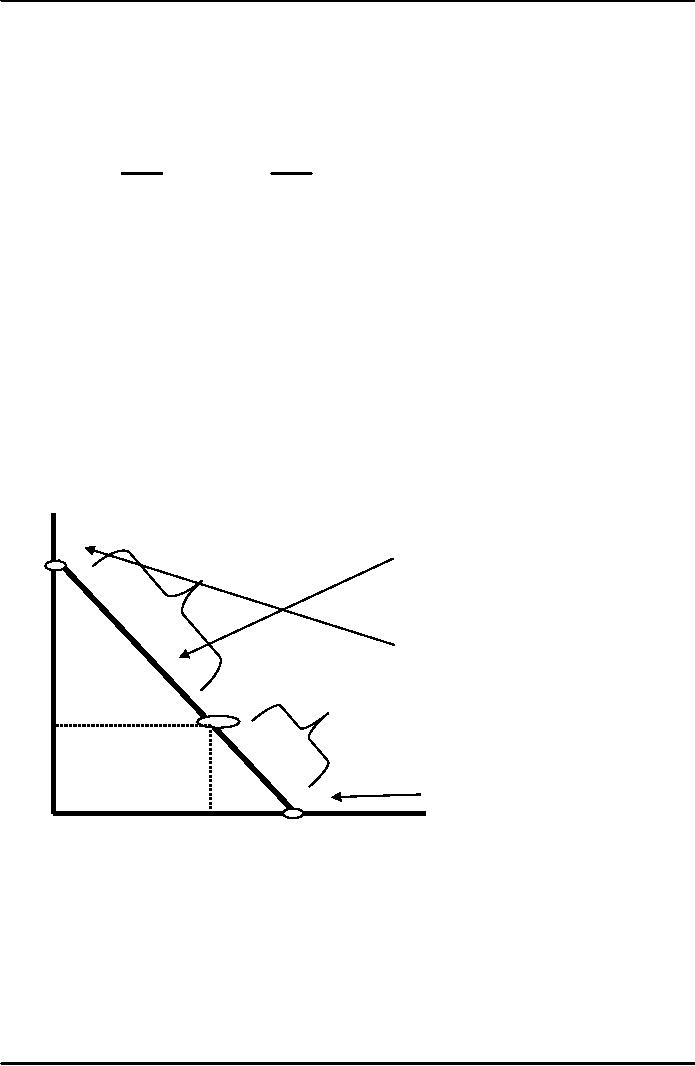
Macroeconomics
ECO 403
VU
LESSON
38
CONSUMPTION
(Continued...)
Consumer's
Budget Constraint
Irving
Fisher's generalization:
C2
Y2
C1
+
r
+
1+r
=
Y1 +
1
So
we can say that
�
�
The
consumer's budget constraint
implies that if the interest
rate is zero, the
budget
constraint
shows that total consumption
in the two periods equals
total income in the
two
periods. In the usual case
in which the interest rate
is greater than zero,
future
consumption
and future income are
discounted by a factor of 1 + r.
�
This
discounting
arises
from the interest earned on
savings. Because the
consumer
earns
interest on current income
that is saved, future income
is worth less than
current
income.
�
Also,
because future consumption is
paid for out of savings
that have earned
interest,
future
consumption costs less than
current consumption.
�
The
factor 1/(1+r) is the price
of second-period consumption measured in
terms of first-
period
consumption; it is the amount of
first-period consumption that
the consumer
must
forgo to obtain 1 unit of
second-period consumption.
Second-period
consumption
B
Consumer's
budget
constraint
Saving
Vertical
intercept is
(1+r)Y1 +
Y2
A
Borrowing
Y2
Horizontal
intercept is
C
Y1 +
Y2/(1+r)
Y1
First-period
consumption
If
he chooses a point between A
and B, he consumes less than
his income in the first
period
and
saves the rest for
the second period. If he
chooses between A and C, he
consumes more
that
his income in the first
period and borrows to make
up the difference.
178
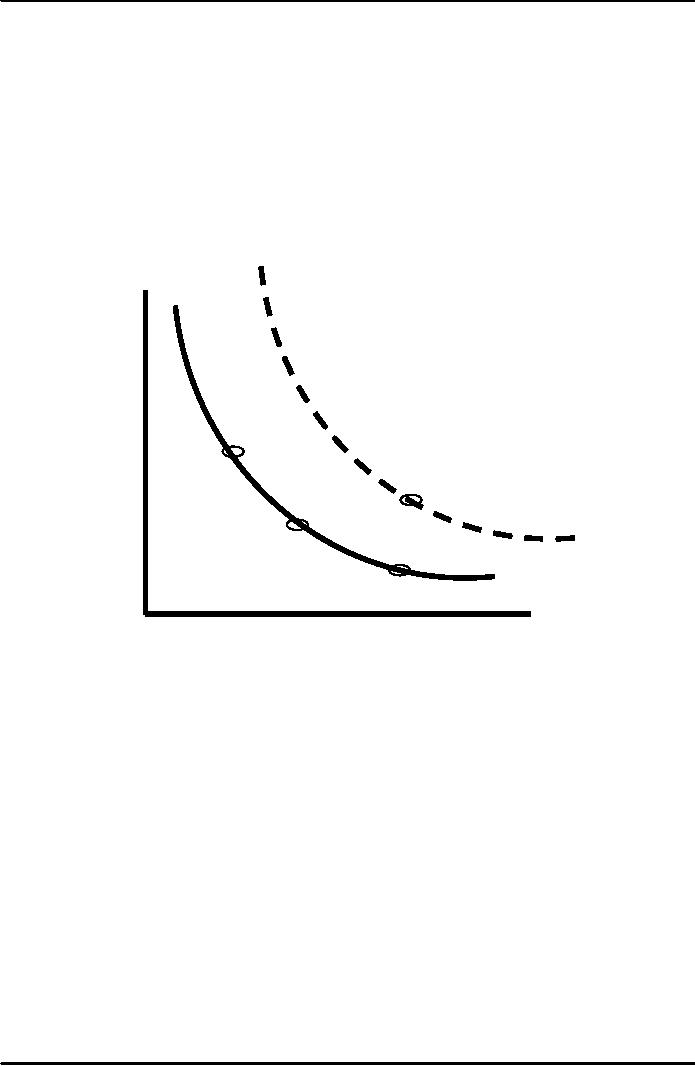
Macroeconomics
ECO 403
VU
Consumer
Preferences
The
consumer's preferences regarding
consumption in the two
periods can be represented
by
indifference
curves.
An
indifference curve shows the
combination of first-period and
second-period consumption
that
makes the consumer equally
happy.
�
The
slope at any point on the
indifference curve shows how
much second-period
consumption
the consumer requires in
order to be compensated for a
1-unit reduction in
first-period
consumption. This slope is
the marginal rate of
substitution between
first-period
consumption
and second-period consumption. It
tells us the rate at which
the consumer is
willing
to substitute second-period consumption
for first-period
consumption.
Second-period
consumption
Y
Z
IC2
X
IC1
W
First-period
consumption
Higher
indifferences curves such as
IC2 are preferred to lower
ones such as IC1. The
consumer
is
equally happy at points W, X, and Y,
but prefers Z to all the
others-- Point Z is on a
higher
indifference
curve and is therefore not
equally preferred to W, X and Y.
Optimization
The
consumer achieves his
highest (or optimal) level
of satisfaction by choosing the
point on
the
budget constraint that is on
the highest indifference
curve. At the optimum, the
indifference
curve
is tangent to the budget
constraint.
179
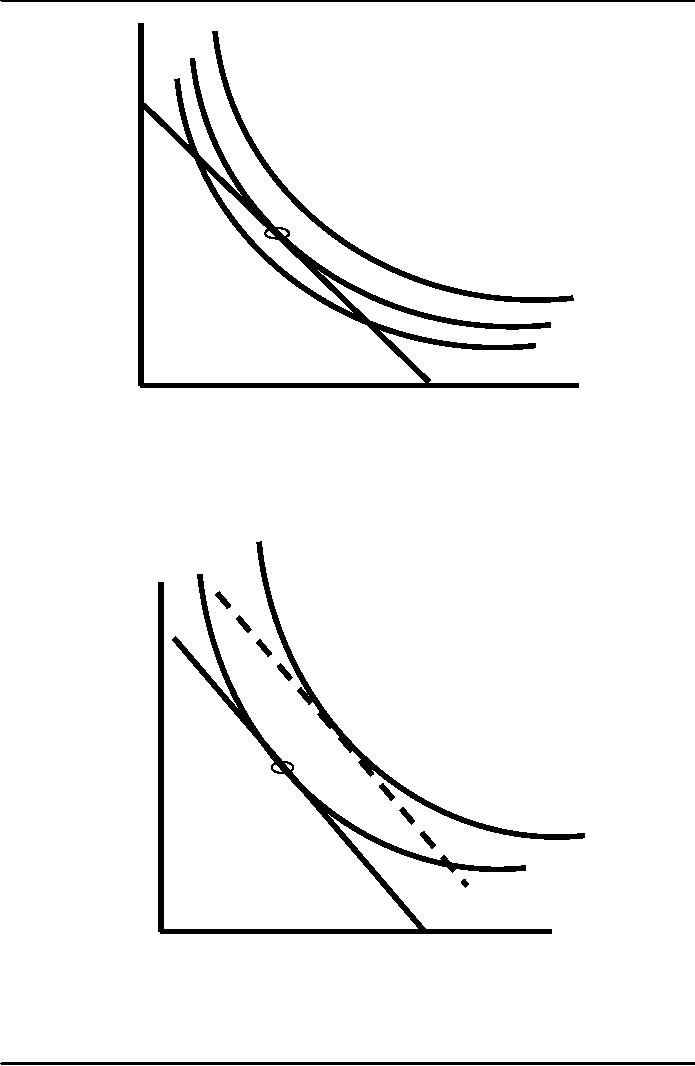
Macroeconomics
ECO 403
VU
Second-period
consumption
O
IC3
IC2
IC1
First-period
consumption
How
changes in income affect
consumption
An
increase in either first- or
second-period income shifts
the budget constraint
outward. If
consumption
in period one and
consumption in period two
are both normal
goods-
those
that
are
demanded more as income
rises, this increase in
income raises consumption in
both
periods.
Second-period
consumption
(1+r)Y1 +
Y2
O
IC2
IC1
First-period
consumption
Y1 +
Y2/(1+r)
180
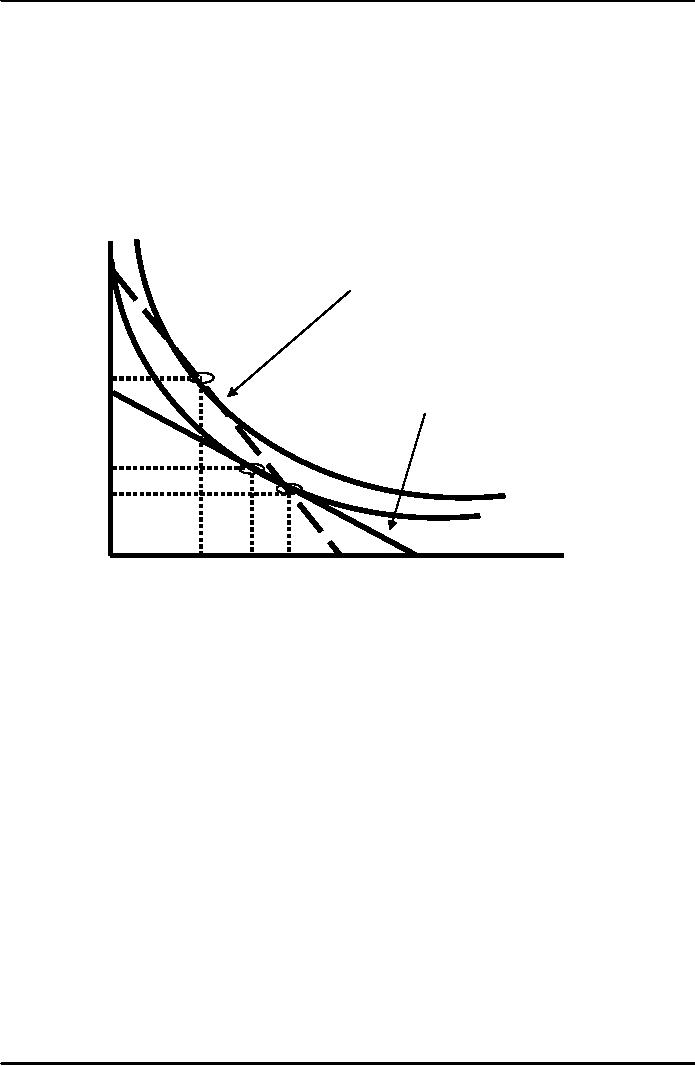
Macroeconomics
ECO 403
VU
How
changes in real interest
rate affect
consumption
�
Economists
decompose the impact of an
increase in the real
interest rate on
consumption
into two effects: an
income
effect and a
substitution
effect.
�
The
income effect is the change
in consumption that results
from the movement to
a
higher
indifference curve.
�
The
substitution effect is the
change in consumption that
results from the change in
the
relative
price of consumption in the
two periods.
Second-
period
consumption
(1+r)Y1 +
Y2
New
budget
constraint
B
Old
budget constraint
A
C
Y2
IC2
IC1
Y1
Y1 +
Y2/(1+r)
First-period
consumption
An
increase in the interest
rate rotates the budget
constraint around the point
C, where C is
(Y1,
Y2).
The
higher interest rate reduces
first period consumption
(move to point A) and raises
second-
period
consumption (move to point
B).
�
Irving
Fisher's Model shows that
depending on the consumer
preferences, changes in
real
interest
rate could either raise or
lower consumption.
�
So,
economic theory alone cannot
predict how interest rate
influences consumption.
Therefore
economists have studied the
empirics of interest rate
affecting the
consumption
and
saving.
Savings
and the Real Interest
Rate
�
Data
shows that there's no
apparent relationship between
the two variables.
Or,
savings
does not depend on interest
rate.
�
Economists
claim that income and
substitution effects of higher
interest rates
approximately
cancel each other.
Constraints
on Borrowings
�
The
inability to borrow prevents
current consumption from
exceeding current income.
A
constraint
on borrowing can therefore be
expressed as C1 ≤
Y1.
181
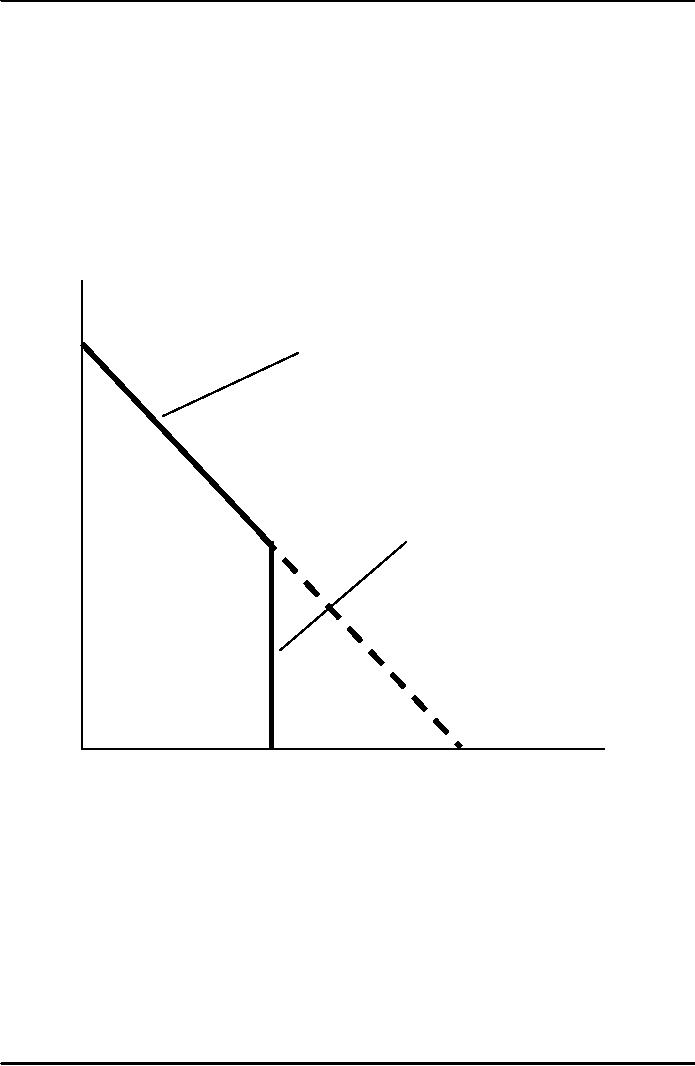
Macroeconomics
ECO 403
VU
�
This
inequality states that
consumption in period one
must be less than or equal
to income
in
period one. This additional
constraint on the consumer is
called a borrowing
constraint,
or
sometimes, a liquidity
constraint.
�
The
analysis of borrowing leads us to
conclude that there are
two consumption
functions.
For
some consumers, the
borrowing constraint is not
binding, and consumption in
both
periods
depends on the present value
of lifetime income.
�
For
other consumers, the
borrowing constraint binds.
Hence, for those consumers
who
would
like to borrow but cannot,
consumption depends only on
current income.
�
If
the consumer cannot borrow,
he faces the additional
constraint that 1st period
consumption
cannot exceed 1st period income.
2nd period consumption,
C2
Budget
Constraint
Borrowing
Constraint
1st period consumption,
C1
Y1
182
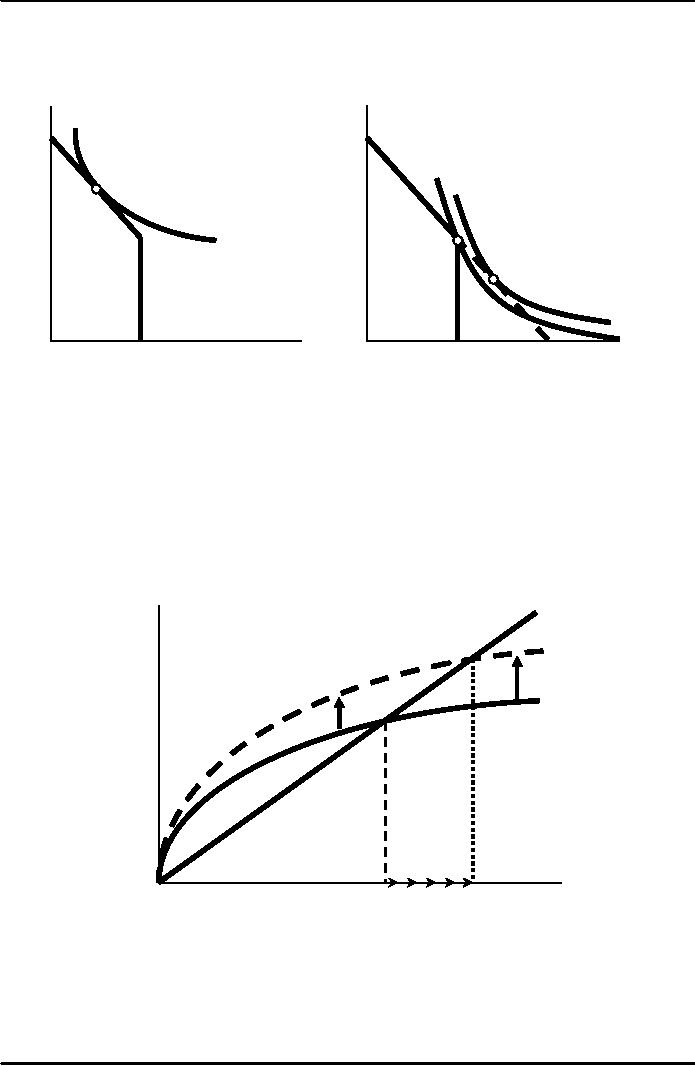
Macroeconomics
ECO 403
VU
a:
borrowing constraint is
b:
borrowing constraint is
not
binding
binding
2nd period
2nd period
consumption
consumption
,
C2
,
C2
E
D
1st period
1st period
Y1
Y1
consumption,
C1
consumption,
C1
High
Japanese Savings
Rate
�
Japan
has one of the world's
highest savings rate.
�
On
one hand, many economists
believe that this is a key
to the rapid growth
Japan
experienced
in the decades after World
War II, The Solow
growth model also shows
that
saving
rate is a primary determinant of a
country's steady state level
of income.
An
increase in the saving rate
raises investment causing
the capital stock to grow
toward a
new
steady state
Investment
δk
and
depreciation
s2 f(k)
s1 f(k)
k
k *
k *
2
1
�
On
the other hand, some
economists say that high
savings rate has contributed
to Japan's
slump
during 1990s.High savings
means lower consumption
which according to
IS-LM
model
translates into low
aggregate demand and reduced
income.
�
Why
Do Japanese consume so less or
save so much?
It is harder
for households to borrow in
Japan
183

Macroeconomics
ECO 403
VU
In case of
borrowing to purchase a house
(the most common cause of
borrowing), down
payment
rates are very high
(up to 40%)
Japanese Tax
system encourages saving by
taxing capital income very
lightly
Japanese
are more risk averse
and patient.
184
Table of Contents:
- INTRODUCTION:COURSE DESCRIPTION, TEN PRINCIPLES OF ECONOMICS
- PRINCIPLE OF MACROECONOMICS:People Face Tradeoffs
- IMPORTANCE OF MACROECONOMICS:Interest rates and rental payments
- THE DATA OF MACROECONOMICS:Rules for computing GDP
- THE DATA OF MACROECONOMICS (Continued…):Components of Expenditures
- THE DATA OF MACROECONOMICS (Continued…):How to construct the CPI
- NATIONAL INCOME: WHERE IT COMES FROM AND WHERE IT GOES
- NATIONAL INCOME: WHERE IT COMES FROM AND WHERE IT GOES (Continued…)
- NATIONAL INCOME: WHERE IT COMES FROM AND WHERE IT GOES (Continued…)
- NATIONAL INCOME: WHERE IT COMES FROM AND WHERE IT GOES (Continued…)
- MONEY AND INFLATION:The Quantity Equation, Inflation and interest rates
- MONEY AND INFLATION (Continued…):Money demand and the nominal interest rate
- MONEY AND INFLATION (Continued…):Costs of expected inflation:
- MONEY AND INFLATION (Continued…):The Classical Dichotomy
- OPEN ECONOMY:Three experiments, The nominal exchange rate
- OPEN ECONOMY (Continued…):The Determinants of the Nominal Exchange Rate
- OPEN ECONOMY (Continued…):A first model of the natural rate
- ISSUES IN UNEMPLOYMENT:Public Policy and Job Search
- ECONOMIC GROWTH:THE SOLOW MODEL, Saving and investment
- ECONOMIC GROWTH (Continued…):The Steady State
- ECONOMIC GROWTH (Continued…):The Golden Rule Capital Stock
- ECONOMIC GROWTH (Continued…):The Golden Rule, Policies to promote growth
- ECONOMIC GROWTH (Continued…):Possible problems with industrial policy
- AGGREGATE DEMAND AND AGGREGATE SUPPLY:When prices are sticky
- AGGREGATE DEMAND AND AGGREGATE SUPPLY (Continued…):
- AGGREGATE DEMAND AND AGGREGATE SUPPLY (Continued…):
- AGGREGATE DEMAND AND AGGREGATE SUPPLY (Continued…)
- AGGREGATE DEMAND AND AGGREGATE SUPPLY (Continued…)
- AGGREGATE DEMAND AND AGGREGATE SUPPLY (Continued…)
- AGGREGATE DEMAND IN THE OPEN ECONOMY:Lessons about fiscal policy
- AGGREGATE DEMAND IN THE OPEN ECONOMY(Continued…):Fixed exchange rates
- AGGREGATE DEMAND IN THE OPEN ECONOMY (Continued…):Why income might not rise
- AGGREGATE SUPPLY:The sticky-price model
- AGGREGATE SUPPLY (Continued…):Deriving the Phillips Curve from SRAS
- GOVERNMENT DEBT:Permanent Debt, Floating Debt, Unfunded Debts
- GOVERNMENT DEBT (Continued…):Starting with too little capital,
- CONSUMPTION:Secular Stagnation and Simon Kuznets
- CONSUMPTION (Continued…):Consumer Preferences, Constraints on Borrowings
- CONSUMPTION (Continued…):The Life-cycle Consumption Function
- INVESTMENT:The Rental Price of Capital, The Cost of Capital
- INVESTMENT (Continued…):The Determinants of Investment
- INVESTMENT (Continued…):Financing Constraints, Residential Investment
- INVESTMENT (Continued…):Inventories and the Real Interest Rate
- MONEY:Money Supply, Fractional Reserve Banking,
- MONEY (Continued…):Three Instruments of Money Supply, Money Demand